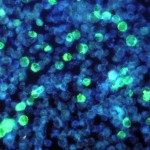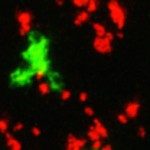Link to Pubmed [PMID] – 20951068
Immunity 2010 Oct;33(4):632-44
Recognition of NKG2D ligands by natural killer (NK) cells plays an important role during antitumoral responses. To address how NKG2D engagement affects intratumoral NK cell dynamics, we performed intravital microscopy in a Rae-1β-expressing solid tumor. This NKG2D ligand drove NK cell accumulation, activation, and motility within the tumor. NK cells established mainly dynamic contacts with their targets during tumor regression. In sharp contrast, cytotoxic T lymphocytes (CTLs) formed stable contacts in tumors expressing their cognate antigen. Similar behaviors were observed during effector functions in lymph nodes. In vitro, contacts between NK cells and their targets were cytotoxic but did not elicit sustained calcium influx nor adhesion, whereas CTL contact stability was critically dependent on extracellular calcium entry. Altogether, our results offer mechanistic insight into how NK cells and CTLs can exert cytotoxic activity with remarkably different contact dynamics.

